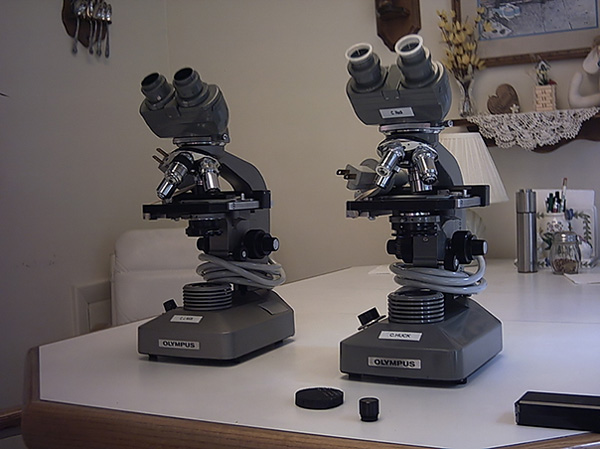
|
BEING INNOVATIVE IN MICROSCOPY by Chuck Huck, USA |
My interest in microscopy began in fourth year high school and then carried over into premed in college, although I never became a doctor. My interest, however, never ceased over all these years. Many of the slides I purchased from Turtox Biological Supply Company in Chicago to get me through some exams I still have in my slide collection. Maybe if I put it all on eBay I could get a million dollars for the entire collection as I think some are very rare—but who knows. (You know what people pay on eBay, often ludicrous.)
Occasions arise where one desires a microscope beyond the toy stage, and that is where I was back in the 1950s. But after using Bausch & Lomb microscopes in lab class, I became captivated with using these instruments.
A few years ago, I decided to try to upgrade from what I had to better quality microscopes. At the time I had only a monocular standard vertical tube microscope in excellent condition with a mechanical stage. But the bug was there and I wanted more, although I took many 35mm photomicrographs through that scope that turned out very well, and I still have them in my collection, although my mounting technique ranges from very good to poor.
I decided to pay a visit to a local science and surplus center and found two stripped-down Olympus microscopes for about $40 each. These bare stands were from a medical school but in great shape, equipped with built-in illumination and mechanical stages but sans oculars, objectives, and condensers.
Over the next few years, I upgraded these microscopes with a full range of oculars and objectives, condensers and binocular heads (purchased off eBay), and enclosures converted from old 8mm Bell and Howell projector cases, and these work just great as they are constructed of heavy wood and fabric and are a lot better constructed and cheaper than some of the flimsy microscope cases being sold today.
In microscopy, one can certainly be innovative and be watchful for something to improve his/her techniques. One simply must have an open mind. None of us will achieve the results of the working microscopist who uses the very best (very expensive) optical and electronic equipment—but I believe we have more fun being innovative while achieving excellent results with what we have.
Here is a photo of the two Olympus bino scopes mentioned above. Although they are identical, they have some minor differences, such as plain or crackle finish and the on-off light switch—but they are basically the same model—and they are fine intruments.
Comments to the author, Chuck Huck, are welcomed.

Please report any Web problems or offer general comments to the Micscape Editor.
Micscape is the on-line monthly magazine of the Microscopy UK web site at Microscopy-UK.